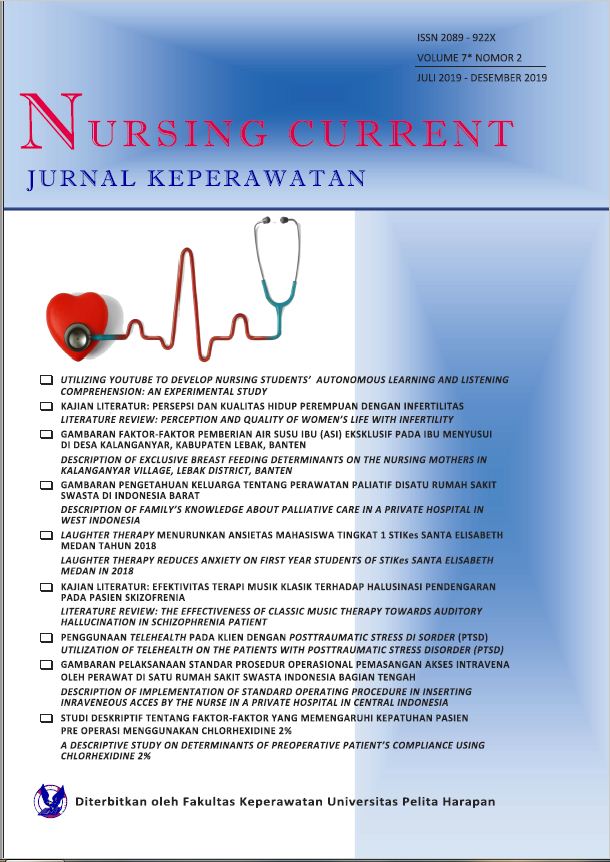DESCRIPTION OF IMPLEMENTATION OF STANDARD OPERATING PROCEDURE IN INSERTING INRAVENOUS ACCES BY THE NURSE IN A PRIVATE HOSPITAL IN CENTRAL INDONESIA [GAMBARAN PELAKSANAAN STANDAR PROSEDUR OPERASIONAL PEMASANGAN AKSES INTRAVENA OLEH PERAWAT DI SATU RUMAH SAKIT SWASTA INDONESIA BAGIAN TENGAH]
DOI:
https://doi.org/10.19166/nc.v7i2.2315Schlagworte:
Hospital, Intravenous access, Standard Operating ProcedureAbstract
Nosocomial infection is one of the common infections that occur in hospitals and other health facilities, which is caused by a mismatch in the implementation of invasive measures such as the intravenous access with the applicable Standard Operating Procedure (SOP). This study aimed to determine the description of the implementation of the SOP of the intravenous access in one private hospital in central Indonesia. The study used a quantitative descriptive design with a total population of 10 nurses using total sampling technique. The study used a checklist sheet which was adapted from the SOP of the hospital where the study was conducted. The results showed all respondents did not carry out the procedure of intravenous access in accordance with the applicable SOP at the hospital. There were nine from 15 steps of implementation of the SOP of the intravenous access do not reach 100%. The hospital is expected to make efforts to improve nurses' compliance in taking action in accordance with SOP, such as forming an audit team to improve compliance with SOP implementation, periodic internal audits, providing facilities for hand-washing (paper-towels, hand-rub, soap for hand-washing), provide adequate gloves, and disinfection equipment. In addition, it is necessary to refresh information regularly about SOP of invasive actions.
BAHASA INDONESIA Infeksi nosokomial merupakan salah satu infeksi umum yang terjadi di rumah sakit dan fasilitas kesehatan lainnya yang disebabkan oleh ketidaksesuaian pelaksanaan tindakan invasif seperti pemasangan akses intravena dengan Standar Prosedur Operasional (SPO) yang berlaku. Penelitian ini bertujuan untuk mengetahui gambaran pelaksanaan SPO pemasangan akses intravena di salah satu rumah sakit swasta di Indonesia bagian tengah. Desain penelitian menggunakan desain deskriptif kuantitatif dengan populasi seluruh perawat ruangan yang berjumlah 10 orang dengan teknik total sampling. Instrumen menggunakan lembar checklist yang diadaptasi dari SPO rumah sakit tempat penelitian dilakukan. Hasil penelitian menunjukkan seluruh responden tidak melaksanakan prosedur pemasangan akses intravena sesuai dengan SPO yang berlaku di rumah sakit. Ada sembilan dari 15 langkah pemasangan akses intravena yang tidak mencapai 100%. Pihak rumah sakit diharapkan dapat melakukan upaya untuk meningkatkan kepatuhan perawat dalam melakukan tindakan sesuai dengan SPO, seperti pembentukan tim audit guna meningkatkan kepatuhan pelaksanaan SPO, audit internal berkala, menyediakan fasilitas untuk mencuci tangan (paper-towels, hand-rub, sabun untuk mencuci tangan), menyediakan sarung tangan yang memadai, dan alat desinfeksi. Selain itu perlu diadakan penyegaran informasi secara berkala mengenai SPO tindakan invasif.
Literaturhinweise
Ari, E., Triastuti, L., & Heni, S. (2009). Perbedaan teknik mendesinfeksi Alkohol 70% antara cara spray dengan oles saat pemasangan infus dalam menurunkan jumlah bakteri pada site infus di Santo Yusup Bandung. Jurnal Keperawatan, 10(19), 76-84. https://media.neliti.com/media/publications/220399-none.pdf
CDC. (2018). Guidance for the selection and use of Personal Protective Equipment (PPE) in healthcare settings. https://www.cdc.gov/HAI/pdfs/ppe/PPEslides6-29-04.pdf
Darmadi. (2008). Infeksi nosokomial: Problematika dan pengendaliannya. Jakarta: Salemba Medika
Eliwarti. (2016). Hubungan faktor-faktor kepatuhan perawat dalam penerapan identifikasi pasien sebelum pemberian obat-obatan di ruang rawat inap penyakit dalam RSUP Dr. M. Djamil Padang Tahun 2015. http://scholar.unand.ac.id/12291/5/BAB%20I%20%28pendahuluan%29.pdf
Hariati, S. (2017). Hubungan lama pemasangan infus, teknik desinfeksi pemasangan infus dan dressing infus dengan kejadian flebitis pada balita di ruang Lili RSUD Penajam Paser Utara. http://paperless.umkt.ac.id/mahasiswa/detail_metadata/346/
Hewitt, T., Chreim, S., & Forster, A. (2016). Double checking: A second look. Journal of Evaluation in Clinical Practice, 22, 267-274. https://doi.org/10.1111/jep.12468 PMid:26568537 PMCid:PMC5063127
McGinley, P. (2011). Design for reliability: Barcoded medication administration. https://www.psqh.com/analysis/design-for-reliability-barcoded-medicationadministration/
Potter, P. A. & Perry, A. G. (2006). Buku ajar fundamental keperawatan: Konsep, proses, dan praktik. Jakarta: EGC
Potter, P. A. & Perry, A. G. (2010). Fundamental keperawatan. Buku 2. Jakarta: EGC
Putra, M. U. K. (2012). Hubungan tingkat pengetahuan dan sikap dengan perilaku penggunaan alat pelindung diri pada mahasiswa profesi Fakultas Ilmu Keperawatan Universitas Indonesia (Thesis, Universitas Indonesia). http://lib.ui.ac.id/file?file=digital/20301537-S42026-Moch.%20Udin%20Kurnia%20Putra.pdf
Quental, B., Saad, R., Duarte, L., Oliveira, J., & Frazilio, A. (2015). Outbreak of bacterial phlebitis related to peripheral intravenous catheters at a general hospital in Brazil. Antimicrobial Resistance & Infection Control 4(Suppl 1). https://doi.org/10.1186/2047-2994-4-S1-P215 PMCid:PMC4475110
United States Department of Labor. (2018). Personal protective equipment. https://www.osha.gov/SLTC/personalprotectiveequipment/
Downloads
Veröffentlicht
Zitationsvorschlag
Ausgabe
Rubrik
Lizenz
Authors who publish with this journal agree to the following terms:
1) Authors retain copyright and grant the journal right of first publication with the work simultaneously licensed under a Creative Commons Attribution License (CC-BY-SA 4.0) that allows others to share the work with an acknowledgement of the work's authorship and initial publication in this journal.
2) Authors are able to enter into separate, additional contractual arrangements for the non-exclusive distribution of the journal's published version of the work (e.g., post it to an institutional repository or publish it in a book), with an acknowledgement of its initial publication in this journal.
3) Authors are permitted and encouraged to post their work online (e.g., in institutional repositories or on their website). The final published PDF should be used and bibliographic details that credit the publication in this journal should be included.

This work is licensed under a Creative Commons Attribution-ShareAlike 4.0 International License.






